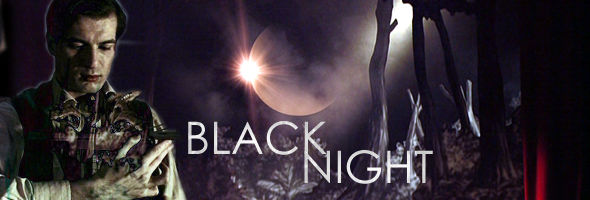
BLACK NIGHT
Color, 2005, 90m. / Directed by Olivier Smolders / Starring Philippe Corbisier, Iris De Busschere, Yves-Marie Gnahoua / Cult Epics (US R1 NTSC) / WS (1.85:1) (16:9) / DD2.0
SPIRITUAL EXERCISES
Color/B&W, 1984-1999, 180m. / Directed by Olivier Smolders / Cult Epics (US R1 NTSC)
Unknown outside of die hard arthouse circles, Belgian director Olivier Smolders has been turning out 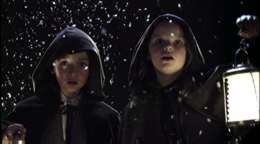 surreal, often inscurtable short films since the mid-1980s. His work teems with imagery involving human skin, religious inconography, and reptiles and insects, while his formal aesthetic style immediately invites comparisons with other European (or Euro-friendly) directors, most obviously Peter Greenaway (whose A Zed and Two Noughts is an obvious influence), Terry Gilliam, Francois Ozon, and Luis Bunuel. Eventually he completed a
surreal, often inscurtable short films since the mid-1980s. His work teems with imagery involving human skin, religious inconography, and reptiles and insects, while his formal aesthetic style immediately invites comparisons with other European (or Euro-friendly) directors, most obviously Peter Greenaway (whose A Zed and Two Noughts is an obvious influence), Terry Gilliam, Francois Ozon, and Luis Bunuel. Eventually he completed a 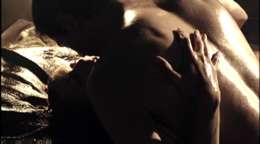 feature-length film, shot on DV but manipulated to look for all the world like a moody 35mm film, entitled Black Night (Nuit Noire), and its release has allowed his entire body of work to finally gain some appreciation in North America thanks to two releases from Cult Epics.
feature-length film, shot on DV but manipulated to look for all the world like a moody 35mm film, entitled Black Night (Nuit Noire), and its release has allowed his entire body of work to finally gain some appreciation in North America thanks to two releases from Cult Epics.
More a dreamlike experimental experience than a coherent narrative, Black Night begins with a pair of old men unveiling a small snowbound stage with two child puppets. Intercut with random shots of insects, the story focuses in on the two children, now real, a brother and sister. After the death of the young girl, the boy, Oscar (Rodriguez), grows up to take over as an animal conservator at his father's Natural Sciences Museum, while the world has been consumed entirely in darkness except for a few fleeting seconds of sunlight each day (a device mirrored by the symbolic image of stage 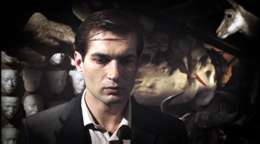 curtains opening and closing). One day he finds one of his coworkers, an African woman, ailing in his bed, and she and Oscar copulate (or do they?) before she dies. Then things get really strange, as his bed is taken over by a giant coccoon...
curtains opening and closing). One day he finds one of his coworkers, an African woman, ailing in his bed, and she and Oscar copulate (or do they?) before she dies. Then things get really strange, as his bed is taken over by a giant coccoon...
Though some critics may be tempted to find some deeper underlying meaning in all of the fragmented images of Black Night, the film really works best as a string of visually stunning scenes in which mankind and Mother Nature comingle in some sort of deeply uneasy symbiosis. The actors mainly function as additional visual objects, though Rodriguez does well in a leading role which requires him to devolve from a stoic, buttoned-up mannequin to a sweaty, frenzied wreck. And of course, this being an art film, there's a lot of female nudity, though it's rendered in a very anthropological fashion.
Cult Epics' DVD of Black Night presents the film in an impressive anamoprhic transfer which belies its digital video origins; the saturated colors and omnipresent black shadows come across just fine, and the French stereo soundtrack (with optional English subtitles) sounds clear throughout with a highly atmospheric and unnerving music score. Extras include a 17-minute reel of deleted scenes (nothing too remarkable, but a lot more bug footage), an amusing behind the scenes featurette that culminates on a remarkably naked and slimy note, an interview with Smolders about his maiden feature film voyage, an alternate festival version of his "Spiritual Exercises" short, and easily the most bizarre of all, a segment entitled "About Black Night" with a French narrator rattling off a string of various symbolic associations tied to the film's recurring visual images (a sample: "An abyss, a hole, a natural orifice, a star, fear of the void, of being devoured, a white series: white particles, snow, speramtozoa, Japanese cherry trees, mother of pearl in a shell...").
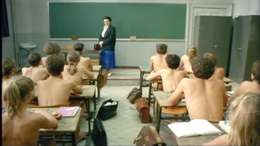 If Black Night is the culmination of Smolders' directorial mind to date, an additional Cult Epics DVD, Spiritual Exercises, shows the foundation being laid with ten short films showing his development over a fifteen year period. The films are shown in what appears to be no particular order. "Adoration" follows a cannibalistic murderer who uses a camera as a tool in his trade; "Seuls" presents an affecting portrait of autistic children; "Point de Fuite" (the funniest of the bunch) presents a math teacher confounded when her entire class shows up nude; "Mort a Vignole"
If Black Night is the culmination of Smolders' directorial mind to date, an additional Cult Epics DVD, Spiritual Exercises, shows the foundation being laid with ten short films showing his development over a fifteen year period. The films are shown in what appears to be no particular order. "Adoration" follows a cannibalistic murderer who uses a camera as a tool in his trade; "Seuls" presents an affecting portrait of autistic children; "Point de Fuite" (the funniest of the bunch) presents a math teacher confounded when her entire class shows up nude; "Mort a Vignole" 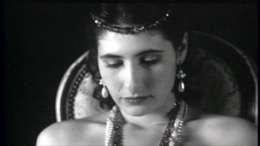 uses monochromatic home movie footage to document a watery tragedy; "L'Amateur" features a fledgling filmmaker encountering the female forms in all its age-related permutations; "Neuvaine" draws disturbing visual parallels between religious ceremony, drug use and animal slaughter; "La Philosophe dans le boudoir" features explicit recitations from the famous Marquis De Sade novel over beautiful black and white portraits and figure studies of various actors (with "Ravissements" offering an alternate version of the same film); "L'art d'aimer" etches a portrait of residents at a nursing home talking about a very violent incident; and "Pensees et visions d'une tete coupee" (the longest of the films) features a strange art gallery guide explicating the meaning of a series of paintings as the visitors become more reflective of their surroundings.
uses monochromatic home movie footage to document a watery tragedy; "L'Amateur" features a fledgling filmmaker encountering the female forms in all its age-related permutations; "Neuvaine" draws disturbing visual parallels between religious ceremony, drug use and animal slaughter; "La Philosophe dans le boudoir" features explicit recitations from the famous Marquis De Sade novel over beautiful black and white portraits and figure studies of various actors (with "Ravissements" offering an alternate version of the same film); "L'art d'aimer" etches a portrait of residents at a nursing home talking about a very violent incident; and "Pensees et visions d'une tete coupee" (the longest of the films) features a strange art gallery guide explicating the meaning of a series of paintings as the visitors become more reflective of their surroundings.
The films are sourced from a variety of video sources of varying quality as well as different aspect ratios; all are watchable but definitely show their age with the appearance of a video master from at least a decade ago. Still, how else are you gonna see 'em? The collection comes with a hefty 48-page booklet containing essays and interviews about the film (in both English and French), two "Court Circuit" shorts summarizing his strongest images ("Spiritual Exercises" and "Images Enamored of Love and Death", and a three-minute excerpt from Black Night.


 surreal, often inscurtable short films since the mid-1980s. His work teems with imagery involving human skin, religious inconography, and reptiles and insects, while his formal aesthetic style immediately invites comparisons with other European (or Euro-friendly) directors, most obviously Peter Greenaway (whose A Zed and Two Noughts is an obvious influence), Terry Gilliam, Francois Ozon, and Luis Bunuel. Eventually he completed a
surreal, often inscurtable short films since the mid-1980s. His work teems with imagery involving human skin, religious inconography, and reptiles and insects, while his formal aesthetic style immediately invites comparisons with other European (or Euro-friendly) directors, most obviously Peter Greenaway (whose A Zed and Two Noughts is an obvious influence), Terry Gilliam, Francois Ozon, and Luis Bunuel. Eventually he completed a  feature-length film, shot on DV but manipulated to look for all the world like a moody 35mm film, entitled Black Night (Nuit Noire), and its release has allowed his entire body of work to finally gain some appreciation in North America thanks to two releases from Cult Epics.
feature-length film, shot on DV but manipulated to look for all the world like a moody 35mm film, entitled Black Night (Nuit Noire), and its release has allowed his entire body of work to finally gain some appreciation in North America thanks to two releases from Cult Epics.
 curtains opening and closing). One day he finds one of his coworkers, an African woman, ailing in his bed, and she and Oscar copulate (or do they?) before she dies. Then things get really strange, as his bed is taken over by a giant coccoon...
curtains opening and closing). One day he finds one of his coworkers, an African woman, ailing in his bed, and she and Oscar copulate (or do they?) before she dies. Then things get really strange, as his bed is taken over by a giant coccoon...
 If Black Night is the culmination of Smolders' directorial mind to date, an additional Cult Epics DVD, Spiritual Exercises, shows the foundation being laid with ten short films showing his development over a fifteen year period. The films are shown in what appears to be no particular order. "Adoration" follows a cannibalistic murderer who uses a camera as a tool in his trade; "Seuls" presents an affecting portrait of autistic children; "Point de Fuite" (the funniest of the bunch) presents a math teacher confounded when her entire class shows up nude; "Mort a Vignole"
If Black Night is the culmination of Smolders' directorial mind to date, an additional Cult Epics DVD, Spiritual Exercises, shows the foundation being laid with ten short films showing his development over a fifteen year period. The films are shown in what appears to be no particular order. "Adoration" follows a cannibalistic murderer who uses a camera as a tool in his trade; "Seuls" presents an affecting portrait of autistic children; "Point de Fuite" (the funniest of the bunch) presents a math teacher confounded when her entire class shows up nude; "Mort a Vignole"  uses monochromatic home movie footage to document a watery tragedy; "L'Amateur" features a fledgling filmmaker encountering the female forms in all its age-related permutations; "Neuvaine" draws disturbing visual parallels between religious ceremony, drug use and animal slaughter; "La Philosophe dans le boudoir" features explicit recitations from the famous Marquis De Sade novel over beautiful black and white portraits and figure studies of various actors (with "Ravissements" offering an alternate version of the same film); "L'art d'aimer" etches a portrait of residents at a nursing home talking about a very violent incident; and "Pensees et visions d'une tete coupee" (the longest of the films) features a strange art gallery guide explicating the meaning of a series of paintings as the visitors become more reflective of their surroundings.
uses monochromatic home movie footage to document a watery tragedy; "L'Amateur" features a fledgling filmmaker encountering the female forms in all its age-related permutations; "Neuvaine" draws disturbing visual parallels between religious ceremony, drug use and animal slaughter; "La Philosophe dans le boudoir" features explicit recitations from the famous Marquis De Sade novel over beautiful black and white portraits and figure studies of various actors (with "Ravissements" offering an alternate version of the same film); "L'art d'aimer" etches a portrait of residents at a nursing home talking about a very violent incident; and "Pensees et visions d'une tete coupee" (the longest of the films) features a strange art gallery guide explicating the meaning of a series of paintings as the visitors become more reflective of their surroundings.
